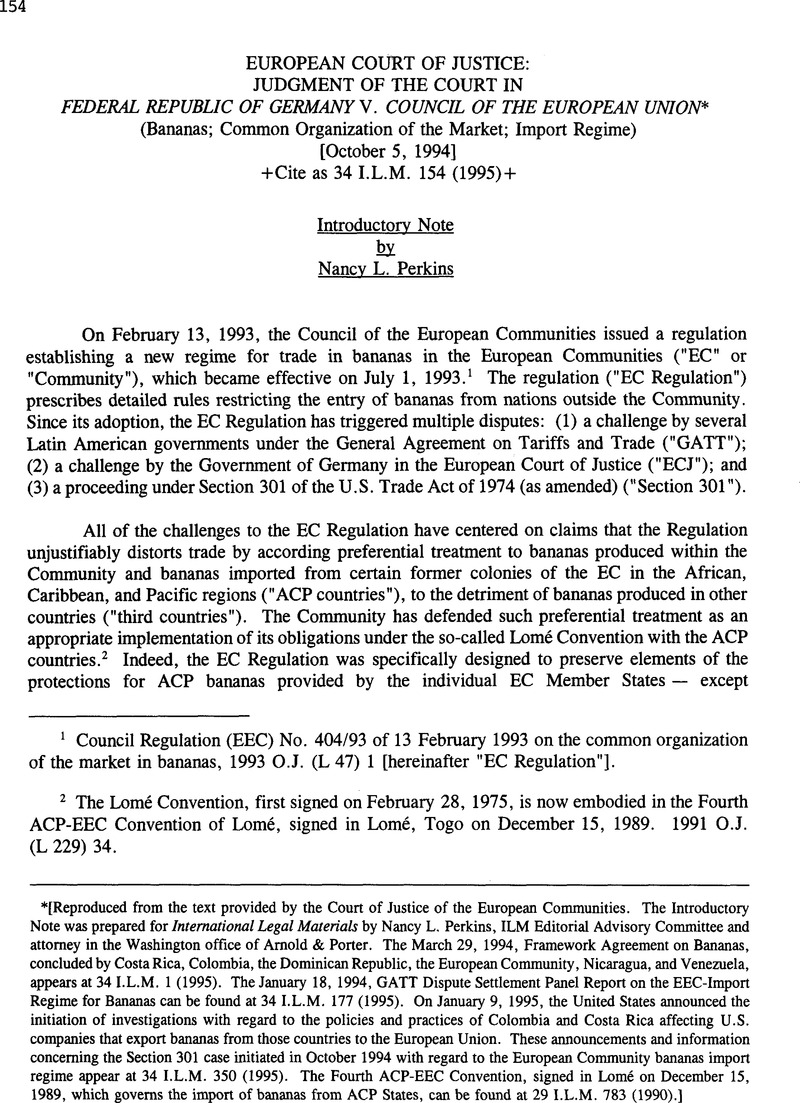No CrossRef data available.
Published online by Cambridge University Press: 27 February 2017

[Reproduced from the text provided by the Court of Justice of the European Communities. The Introductory Note was prepared for International Legal Materials by Nancy L. Perkins, ILM Editorial Advisory Committee and attorney in the Washington office of Arnold& Porter. The March 29, 1994, Framework Agreement on Bananas, concluded by Costa Rica, Colombia, the Dominican Republic, the European Community, Nicaragua, and Venezuela, appears at 34 I.L.M. 1 (1995). The January 18, 1994, GATT Dispute Settlement Panel Report on the EEC-Import Regime for Bananas can be found at 34 I.L.M. 177 (1995). On January 9, 1995, the United States announced the initiation of investigations with regard to the policies and practices of Colombia and Costa Rica affecting U.S. companies that export bananas from those countries to the European Union. These announcements and information concerning the Section 301 case initiated in October 1994 with regard to the European Community bananas import regime appear at 34 I.L.M. 350 (1995). The Fourth ACP-EEC Convention, signed in Lome on December 15, 1989, which governs the import of bananas from ACP States, can be found at 29 I.L.M. 783 (1990).]
1 Council Regulation (EEC) No. 404/93 of 13 February 1993 on the common organization of the market in bananas, 1993 O.J. (L 47) 1 [hereinafter “EC Regulation”].
2 The Lomé Convention, first signed on February 28, 1975, is now embodied in the Fourth ACP-EEC Convention of Lome, signed in Lome, Togo on December 15, 1989. 1991 O.J. (L 229) 34.
3 See EC Regulation, para. 15 (stating that among the EC Regulation's goals is “to ensure a satisfactory marketing of bananas produced within the Community and of products originating in the ACP States within the framework of the Lome Convention Agreements”).
4 The principal Latin American states exporting bananas to the EC were Colombia, Costa Rica, Ecuador, Guatemala, Honduras, Nicaragua, and Panama. (Belize and Suriname, although technically Central American and South American countries respectively, are considered Caribbean states by the EC in accordance with the Lomé Convention. They therefore are not included in references here to “Latin American” states.)
5 Eurostat data for January-December, 1992. (Quantities in “tons” refer to metric tons.) Although the Eurostat figures also include plantains, plantains account for a very small proportion of the total trade.
6 Eurostat data. ACP countries exporting bananas to the EC include: Belize, Cape Verde, Dominica, Cameroon, Grenada, the Grenadines, Jamaica, the Ivory Coast, Madagascar, St. Lucia, St. Vincent, Somalia and Suriname.
7 Eurostat data.
8 Eurostat data, showing customs value of 1,168,403,000 ECUs for 2,833,605 tons of imported fresh bananas.
9 Brent Borrell & Sandy Cothbertson, “EC Banana Policy 1992: Picking the Best Option” (Center for International Economics 1991) at 8. These price discrepancies were stressed by both the German and the British Governments in their statements to the ECJ in the German challenge to the EC Regulation.
10 EC Regulation, art. 18:1. The tariff quota applies to not only fresh bananas, but also to frozen bananas, banana juice, banana jams and pastes, and a variety of other preserved banana products.
11 EC Regulation, art. 15(1)
12 he single-year maximum quantity of EC imports of ACP bananas during this period was 690,699 tons in 1992. Eurostat data.
13 EC Regulation, art. 18(1)&(2). 1
14 Id. art. 18(1) & (2). 15
15 See EC Regulation, arts. 19 & 20; Commission Regulation (EEC) No. 1442/93 of 10 June 1993 laying down detailed rules for the application of the arrangements for importing bananas into the Community, 1993 O.J. (L 142) 6; Commission Regulation (EEC) No. 1443/93 of 10 June 1993 on transitional measures for the application of the arrangements for importing bananas into the Community in 1993, 1993 O.J. (L 142) 16.
16 EC Regulation, art. 19(1).
17 Commission Regulation (EEC) No. 1442/93, supra note 26, art. 13(1) & (2).
18 Community bananas are produced in the Canary Islands, Crete, Guadeloupe, Madeira, and Martinique.
19 EC Regulation, art. 12. This quantity corresponds to 129 percent of the quantity supplied by EC dependencies to the twelve Member States in 1992. Eurostat data for 1992 shows “imports” of 659,838 tons of fresh bananas from EC Member State dependencies.
20 Id. para. 14 & art. 13.
21 Such an additional increase will be effected to accommodate the entry of Austria, Finland and Sweden into the European Union.
22 The most-favored-nation claim raised by the Latin American complainants is now effectively moot. On December 8, 1994, the GATT contracting parties adopted a waiver of GATT rules with respect to trade preferences accorded pursuant to the Lomé Convention. The waiver does not affect the GATT's application to other aspects of the EC Regulation, however, and there has been some suggestion that Guatemala may seek to initiate a new GATT challenge to such other aspects of the Regulation under the new World Trade Organization Agreement.